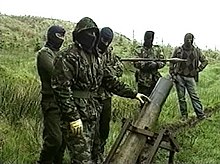
Back Campaña del Ejército Republicano Irlandés Provisional Spanish Campanha do Exército Republicano Irlandês Provisório Portuguese
| Provisional IRA campaign | ||||||||
|---|---|---|---|---|---|---|---|---|
| Part of the Troubles | ||||||||
 IRA members showing an improvised mortar and an RPG (1992) | ||||||||
| ||||||||
| Belligerents | ||||||||
|
Supported by: | (RUC) |
(UVF) Other loyalist paramilitary groups | ||||||
| Casualties and losses | ||||||||
|
IRA 293 killed over 10,000 imprisoned at different times during the conflict[3] |
British Armed Forces 643–697 killed RUC 270–273 killed | Loyalist paramilitary groups 28–39 killed | ||||||
|
Others killed by IRA 508[4]–644[5] civilians 1 Irish Army soldier 6 Gardaí 5 other republican paramilitaries | ||||||||
From 1969 until 1997,[6] the Provisional Irish Republican Army (IRA) conducted an armed paramilitary campaign primarily in Northern Ireland and England, aimed at ending British rule in Northern Ireland in order to create a united Ireland.[7][8][9][10]
The Provisional IRA emerged from a split in the Irish Republican Army in 1969, partly as a result of that organisation's perceived failure to defend Catholic neighbourhoods from attack in the 1969 Northern Ireland riots. The Provisionals gained credibility from their efforts to physically defend such areas in 1970 and 1971. From 1971 to 1972, the IRA took to the offensive and conducted a relatively high-intensity campaign against the British and Northern Ireland security forces and the infrastructure of the state. The British Army characterised this period as the "insurgency phase" of the IRA's campaign.
The IRA declared a brief ceasefire in 1972 and a more protracted one in 1975, when there was an internal debate over the feasibility of future operations. The armed group reorganised itself in the late 1970s into a smaller, cell-based structure, which was designed to be harder to penetrate. The IRA then carried out a smaller scale but more sustained campaign, which they characterised as the 'Long War', with the eventual aim of weakening the British government's resolve to remain in Ireland. The British Army called this the "terrorist phase" of the IRA's campaign.
The IRA made attempts in the 1980s to escalate the conflict with the aid of weapons donated by Libya. In the 1990s they also resumed a campaign of bombing economic targets in London and other cities in England.
On 31 August 1994, the IRA called a unilateral ceasefire with the aim of having their associated political party, Sinn Féin, admitted into the Northern Ireland peace process. The organisation ended its ceasefire in February 1996 but declared another in July 1997. The IRA accepted the terms of the Good Friday Agreement in 1998 as a negotiated end to the Northern Ireland conflict. In 2005 the organisation declared a formal end to its campaign and had its weaponry decommissioned under international supervision.
Other aspects of the Provisional IRA's campaign are covered in the following articles:
- For a chronology, see Chronology of Provisional IRA actions
- For the Provisional IRA's armament, see Provisional IRA arms importation
- ^ Taylor, Peter,Behind the mask: The IRA and Sinn Féin, Chapter 21: Stalemate, pp. 246–261.
- ^ "Army paper says IRA not defeated". BBC News. 6 July 2007. Retrieved 13 March 2014.
- ^ Mallie Bishop, p. 12
- ^ Cite error: The named reference
cain-crosstabs2was invoked but never defined (see the help page). - ^ Lost Lives (2004. Ed's David McKitrick, Seamus Kelters, Brian Feeney, Chris Thornton, David McVea, page 1536)
- ^ Moloney, p. 472
- ^ War in the Shadows: The Guerrilla in History Volume 2 by Robert B. Asprey (ISBN 978-0-595-22594-1), page 1125
- ^ Global Geopolitics: A Critical Introduction by Klaus Dodds (ISBN 978-0-273-68609-5), page 205
- ^ British Civilization by John Oakland (ISBN 978-0-415-26150-0), page 108
- ^ Northern Ireland by Jonathan Tonge (ISBN 978-0-7456-3141-7), page 2